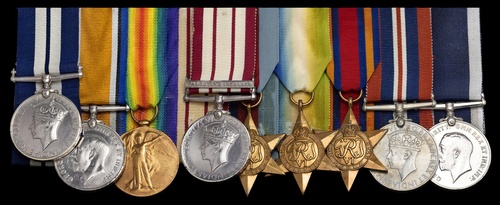
Auction: 25001 - Orders, Decorations and Medals
Lot: 315
(x) The Second World War D.S.M. group of nine awarded to Chief Petty Officer Cook A. V. E. Smithurst, Royal Navy who won his award serving on H.M.S. London
London was the flagship for the escort force that failed to safeguard convoy PQ17 resulting in the loss of two thirds of the convoys vessels
Distinguished Service Medal, G.VI.R. (C.P.O. Cook (S) A Van Eck Smithurst. C/M. 33903); British War and Victory Medals (33903 A.V.E. Smithurst. CK.R.N.); Naval General Service 1915-62, 1 clasp, Palestine 1936-1939 (MX.33903 A.V.E. Smithurst. C.P.O. CK.R.N.); 1939-45 Star; Atlantic Star; Burma Star; War Medal 1939-45; Royal Navy L.S. & G.C., G.V.R. (M 33903 A.V.E. Smithurst C.P.O. CK. H.M.S. Enterprise), contact marks, good very fine (9)
D.S.M. London Gazette 14 June 1945.
Allan Van Eck Smithurst was born on 7 September 1900 at Grantham, Lincolnshire, the son of Percy Smithurst. A baker, Smithurst enlisted in the Royal Navy on 10 September 1918, he was shore based for the duration of the Great War. Remaining in service after the war he served variously on Calypso, Ceres, and Cumberland in 1927 by which time he had been promoted to Leading Cook. On 24 November 1930 he was promoted to Petty Officer Cook and on 22 October 1933 whilst serving on Enterprise he was awarded his L.S. & G.C. Promoted to Chief Petty Officer Cook on 7 November 1934 he was posted to Sussex for service in the Mediterranean qualifying for his Naval General Service Medal.
Shore based at the beginning of the Second World War he was posted to London on 7 February 1941 and served aboard her for the duration of the war.
London was involved in the pursuit of the German battleship Bismarck in May 1941. During this time at sea, many cracks appeared in her upper deck and hull, due to the weight of the new superstructure causing stresses. She entered a commercial shipyard on the River Tyne in October 1941 and was under repair until February 1942. London then spent March-November 1942 in the North Atlantic on convoy protection duties in the company of several US Navy warships.
Convoy PQ 17
On 27 July 1942, convoy PQ-17 departed Iceland for the Soviet Union. Out of 34 merchant ships, only 11 would make it to port. At first, things seemed to be going well for the convoy as they beat off multiple German air attacks with relative ease. But, on 4 July, everything went wrong. An order arrived from Admiral Sir Dudley Pound, the First Sea Lord himself, reading 'Convoy is to scatter'. Fearing an imminent attack from German surface ships like Tirpitz the escort ships fled west while the merchant ships made for the Soviet Union.
But the Tirpitz was nowhere near the convoy, in fact, it was still at its moorings in northern Norway. Instead of saving the convoy from disaster, Admiral Pound's order had doomed PQ-17 to destruction. Over the following week, two thirds of the convoy were sunk by German aircraft and U-Boats. It was the biggest loss to a British convoy of the Second World War.
This period of operations in the heavy North Atlantic seas caused hull cracks and popped rivets in her lower hull, necessitating the ship again going into the dry-dock in December 1942 for strengthening of the hull and for the fitting of newer and more refined radar, and of more light anti-aircraft guns. This refit rectified her hull and was completed in May 1943, with the ship ready for sea in July. After sea trials and loading of ammunition, she was assigned to operate off the South African coast and then to the Eastern Fleet for the rest of the war.
The story of H.M.S. London is the subject of a book written by Iain Ballantyne, ' From Fighting Sail to The Arctic Convoys & Tomorrow's War.', which relates the following about PQ17, stating:
'Relentless air attacks by bombers flying from German airbases in northern Norway, coupled with incendiary attacks by submarines operating in Wolf packs, began to take a heavy toll on the merchant ships with losses increasing daily. On 4 July the First Sea Lord Admiral Pound, expecting a German surface attack in superior strength on the close support group, ordered the cruisers and escort destroyers to turn back to the west and instructed the convoy to scatter. Between 4 and 6 July, 18 freighters were sunk by surface ships, submarines and land-based aircraft. On 7 July three further ships were torpedoed by submarines. On 10 July three ships were bombed and sunk by aircraft. Only when the surviving ships of the convoy began to straggle onto Archangel did it become apparent that the convoy had suffered catastrophic loses. Nine ships of 56,611 tons were sunk by U-Boats; eight ships of 40,376 tons were sunk by the Luftwaffe; and eight ships which were damaged during air attacks were finished off by U-Boats. A total of 24 ships totalling 143,977 tons were lost, along with 3,350 military vehicles, 430 tanks, 210 aircraft and 99,316 tons of war supplies.'
Smithurst was shore pensioned on 1 August 1945. He died at Hastings, Sussex in 1974; sold together with copied research.
Subject to 5% tax on Hammer Price in addition to 20% VAT on Buyer’s Premium.
Estimate
£1,200 to £1,600
Starting price
£950




